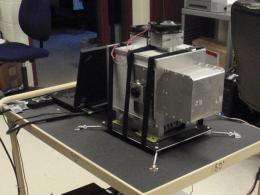Table-top nuclear materials detector shows exact location of radiation sources

(PhysOrg.com) -- A table-top gamma-ray detector created at the University of Michigan can not only identify the presence of dangerous nuclear materials, but can pinpoint and show their exact location and type, unlike conventional detectors.
"Other gamma ray detectors can tell you perhaps that nuclear materials are near a building, but with our detector, you can know the materials are in room A, or room B, for example," said Zhong He, a professor in the Department of Nuclear Engineering and Radiological Sciences.
"This is the first instrument for this purpose that can give you a real-time image of the radiation source. Not only can we tell you what material is there, but we can tell you where it is, and you can find it and walk towards it."
He presented this device, called Polaris, this week at the International Workshop on Room-Temperature Semiconductor Detectors, held in conjunction with 2010 IEEE Nuclear Science Symposium and Medical Imaging Conference in Knoxville, Tenn.
Gamma rays are high-energy photons, or particles of light. They are emitted by dirty bombs and special nuclear materials that could be used for nuclear weapons.
Polaris is composed of 18 cubes of the semiconductor cadmium zinc telluride. Each cube measures and records the energy and three-dimensional position of every gamma ray photon interaction that takes place within the detector. It also determines the direction each photon came from.
A computer connected to the detector uses the energy information to identify the type of material emitting it. Different materials appear in the detector's image as different colors. The device uses the photon direction and position information to show the location of the source.
He underscored why having an image to guide an inspector to a radiation source is especially helpful.
"If you don't have an image, it's like collecting the spectrum of the light in this room," he said. "You wouldn't know what's happening in the room. With an image, obviously, you can see what's happening, and who is here and where they are standing."
Polaris will also be more convenient and portable to use in the field, compared with its current counterparts, He said. It operates at room temperature, whereas the high-purity germanium gamma ray detectors typically used today must be cooled to -200 degrees Celsius or they won't work.
This research was funded by the Department of Defense's Defense Threat Reduction Agency, the Department of Energy, and the Domestic Nuclear Detection Office of the Department of Homeland Security.
The university is pursuing patent protection for the intellectual property, and is seeking commercialization partners to help bring the technology to market.
Provided by University of Michigan
















